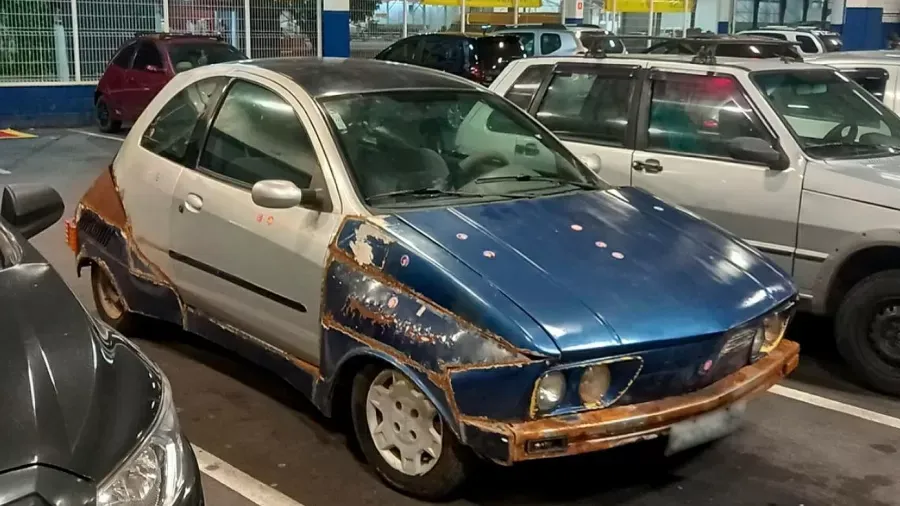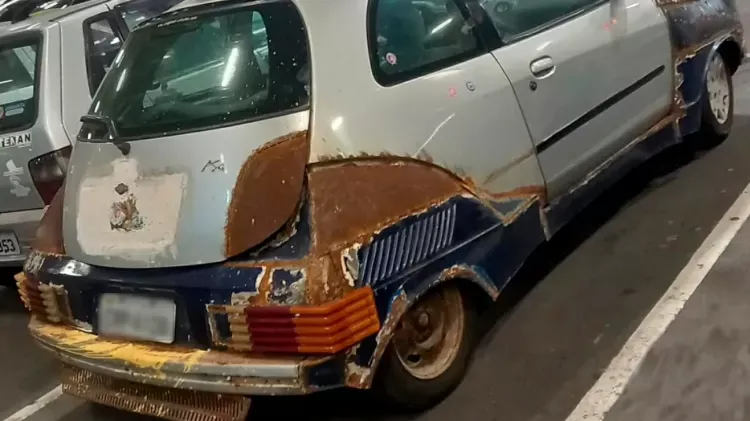O Volkswagen Brasilia It is one of the most iconic cars in the history of Brazilian automotive. Manufactured and sold between the 1970s and 1980s, the model was one of the most beloved of its generation, with a unique design and simplified mechanics that won the hearts of many Brazilian drivers. However, after its discontinuation in the early 1980s, the Brasília fell into oblivion for many, being replaced by more modern models. However, the passion for old cars never fades, and this was evident with the recent invention of an enthusiast from the southern coast of São Paulo, who decided to create the BrasiKa, an unusual fusion between the Volkswagen Brasilia and the modern Ford Ka.
You might be wondering: how would it be possible to combine two such distinct cars, from completely different generations and proposals? Well, the story of BrasiKa begins precisely with this boldness and creativity, resulting in a work that mixes the classic with the modern in a curious and surprising way.
The Invention of BrasiKa: A Mix of Styles and Personality

To better understand what motivated this transformation, we need to go back in time a little. In the 1970s, Volkswagen Brasilia was launched with the aim of being a compact, economical and practical model for Brazilian families. It became known for its rounded shape and simple mechanics, which made it easy to repair. Its production lasted from 1973 until 1982, when it was discontinued. Ford Ka, launched in 1997, represents the era of more modern and urban cars. The proposal was to meet the needs of a young and dynamic public, with a more modern design and much more sophisticated mechanics, typical of cars from the turn of the millennium.
Now, imagine taking the classic and robust design of the Brasília and combining it with the more youthful and modern lines of the Ford Ka. It seems unthinkable, doesn't it? But that's exactly what a resident of Praia Grande, on the southern coast of São Paulo, did. The project, still in progress, has generated controversy and, at the same time, enchantment. He not only maintained the essence of the Brasília, but also brought a contemporary touch by blending it with the design of the Ford Ka.
How BrasiKa Works: The Art of Personalization
The project to transform Brasília into Ka is a true work of adaptation, with bodywork that requires a lot of patience and skill. The process begins at the front, where the front of the Ford Ka was incorporated into the front of the Brasília, including the hood, headlights and grille. However, the rear of the car was kept, which created an interesting combination between the two models. In order for this combination to be possible, the enthusiast responsible for the transformation had to make several modifications, mainly to the fenders and the rear lid.
The back cover of the Ford Ka, for example, underwent modifications to cover the model's taillights, which meant that the rear of the Brasília remained the same, but with the Ka's area adapted to fit perfectly. Similar work was done on the rear fenders, where the wheel arches were filled with metal sheets so that the Ford Ka's parts would fit there. The real magic of this process was managing to maintain the Brasília's original appearance, but at the same time adapting elements of the Ka, such as the taillights and bumper, creating a unique, hybrid look.
One of the most interesting details of the BrasiKa is that the license plate still identifies the model as a Brasilia 1980, which gives this invention its own identity and at the same time refers to the past, carrying the history of the model. It is a clear example of how a passion for old cars can result in something innovative, which mixes love for the past with modernity.
Technical Challenges and Creativity in the Project
The transformation of the Brasília into a Ford Ka was not a simple task. In addition to the bodywork adaptations, the biggest technical challenge was keeping the engine installed in the rear of the vehicle, as in the original version of the Brasília. For those who are not familiar, the Brasilia It is a model that is characterized by having the engine in the rear, which is an uncommon feature in modern cars. This configuration required many modifications to the BrasiKa design, since the Ford Ka's mechanics are geared towards front engines.
As a result, the enthusiast had to make complex adaptations to keep the rear engine, creating a true automotive puzzle. The result is a vehicle that, from a technical point of view, is unlike any other model on the market. The intention was to maintain the practicality and charm of the Brasília, but with the modernity of the Ka, and the project, despite all the difficulties, remains a unique achievement in Brazil.
BrasiKa on the Market: A Unique Car or a Big Madness?

Now that you know a little about how the BrasiKa emerged, the big question is: what do people really think of this bold project? Public opinion is divided. For some, this transformation is an example of creativity and ingenuity, showing that Brazil has a rich automotive culture and that there are no limits to those who want to customize their car. For others, the idea of taking a classic like the Volkswagen Brasilia and transforming it into something completely different is an affront to the model's history, an attempt to distort its essence.
But it is important to remember that, in the world of cars, personal taste has always been and will always be a very subjective matter. Passion for a model can lead someone to create true automotive works of art, and the case of BrasiKa is proof of this. What matters here is the courage to experiment and try something new. After all, customizing cars is a form of expression, and many people have made modifications to their vehicles to suit their own desires and tastes.
Furthermore, the transformation of the Brasilia in Ford Ka It is not a cheap project. The costs of bodywork, mechanical adaptations and design adjustments are not low. It is a job that requires time, money and dedication. Therefore, anyone who decides to follow this path needs to be aware that the project can easily exceed the R$ 20,000, depending on the modifications made.
The Future of BrasiKa: What’s Next?
BrasiKa is currently still in the process of being adapted and finalized. However, it is possible that the project will gain more notoriety as time goes by, especially among custom car enthusiasts and those who enjoy the combination of old and new. It may be that in the future, more people will decide to follow this path and transform their classic vehicles into modern and innovative versions, creating a personalization movement that combines the best of both worlds.
On the other hand, it is possible that this type of transformation will remain a unique and isolated project, intended only for those who truly have a passion for these two cars and want to combine them in a creative way.
In any case, the project of BrasiKa It’s a clear example of how a passion for cars can lead someone to create something unique, whether it’s a work of art or a great madness. What do you think about it? If it were you, would you risk transforming your old vehicle into a modern hybrid, or would you prefer to keep the essence of each model intact? Leave your opinion in the comments and share your vision about this irreverent and creative project that is capturing the attention of many!









